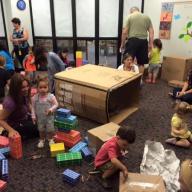During the peak of the pandemic, the federal government provided billions of dollars to help with childcare, subsidizing families and boosting workers’ wages. It was what many in, and interested in, the industry called a needed injection of funds. And it helped sustain both those in need of childcare and that industry.
But, in what some are calling a childcare cliff, that funding was set to expire on Sept. 30, setting the stage for a potential disruption for care affecting children, parents, businesses and that industry.
The ‘Childcare Cliff’
“The accessibility and affordability of quality childcare impacts families, and it is also a business issue,” said Long Island Association President and CEO Matt Cohen, who also chairs the Child Care Council of Suffolk. “The return on investment is undeniable. Data shows that funding to develop sustainable childcare programs leads to economic growth.”
The LIA is seeking to bring the funding expiration issue to the attention of Congress and the region through letters and advocacy while proposing other solutions to ensure what Cohen calls the “long-term viability of the childcare industry.”
“The reason we needed those grants are still there. There’s none of that additional money. It all goes away,” Jennifer Rojas, executive director at the Child Care Council of Suffolk, told the Press. “We want that money to be baselined not as Covid money, but as childcare money, so we can fix the problem rather than give out one-off grants.”
The licensed capacity for childcare on Long Island is 46,366 in Suffolk County and 51,180 in Nassau County, or just under 100,000, Rojas said.
“The childcare industry, well before Covid, had a lot of problems. It’s not structured in a way that’s sustainable and viable, while paying staff a living wage,” Rojas said. “It’s based on what parents can afford to pay. And we have strict staffing ratios. You have to have a certain amount of space and staff depending on the age of children.”
Shital Patel, principal economist focusing on Long Island for the New York State Department of Labor, in a report titled “Women in Long Island’s Workforce,” pointed to childcare issues.
“The lack of affordable quality childcare has long been a barrier preventing mothers of young children from entering the workforce,” she wrote.
In 2021, about 73% or nearly three-quarters of Long Island children under age 6 lived in a household with all available adults working. While childcare impacts fathers as well as mothers, the labor force participation rate of mothers in Nassau County aged 20-64 with children under 6 was 83.7%, while it was 77.4% in Suffolk, according to the report.
Patel said the median annual price of center-based infant care on Long Island was around $20,000. Both counties had approximately 85,000 children under 6, while Suffolk County has nearly 3,200 fewer childcare slots than Nassau County.
“Overall, Long Island still has a childcare “supply gap” of more than 68,500 day care slots,” Patel wrote.
Rojas said that billions of dollars in federal funding went to New York State, helping to sustain the industry. The abrupt end could be the equivalent of an earthquake for the childcare system, which employs teachers, teachers’ assistants, aides and others.
In New York State, Cohen said, “thousands of programs that rely upon this funding could close, resulting in reduced economic output if parents lose their spots and can no longer work.”
Fixing the Childcare System
Rojas said childcare is particularly crucial in areas with a high cost of living such as Long Island where retailers hiked wages, making it even tougher for childcare providers to recruit and cover costs.
“Once this money goes away, I can’t tell you what will happen. This system has been able to cobble together and survive,” she continued, while calling for an extension. “My guess is we will see classrooms close, because they don’t have enough staff. We may see programs close.”
Cohen said that “the immediate need is an appropriation to address the federal funding deadline for childcare centers and avoid catastrophic impacts on the ability of people to work, those in the workforce, and children who benefit from the services of these centers.”
Gov. Kathy Hochul created a childcare task force, including Rojas, set to make recommendations within two months. And the childcare conundrum is hardly new. The Build Back Better Act, which did not pass, included funding and fixes for the childcare industry, and other legislation seeks to address what Rojas calls a bipartisan issue.
“I think it goes back to people thinking it’s a family’s problem to deal with their children. There hasn’t been a commitment to make it a public good, like public schools,” Rojas said of any resistance. “It comes from a historical perspective that little children should be with their family and this is a family issue.”
She added that especially with two working parents and lower-wage jobs in sectors such as restaurants and retail, childcare can be necessary.
“We have an economy where it’s difficult for a parent to stay home with their child,” Rojas said. “People need to work.”
Cohen called for new federal investments in the childcare workforce, which he said “is woefully underpaid”; increasing eligibility limits for assistance; a tax credit to help employers provide childcare for employees; and expanded federal tax write-offs to offset expenses for families.
“We need this money to continue for childcare, but not as grants,” Rojas said. “We need actual investments in the system. No more Band-Aids. Let’s fix the system.”




























